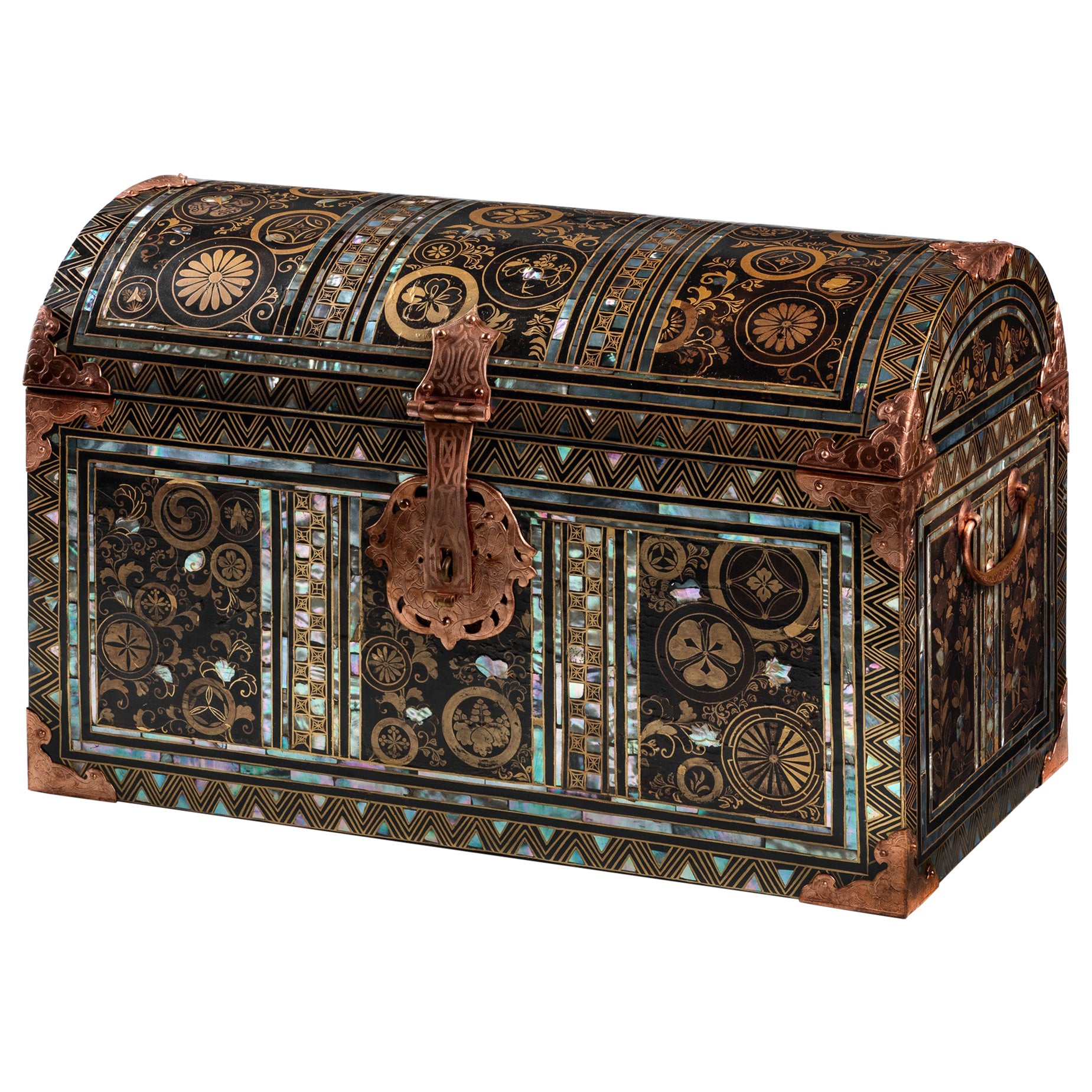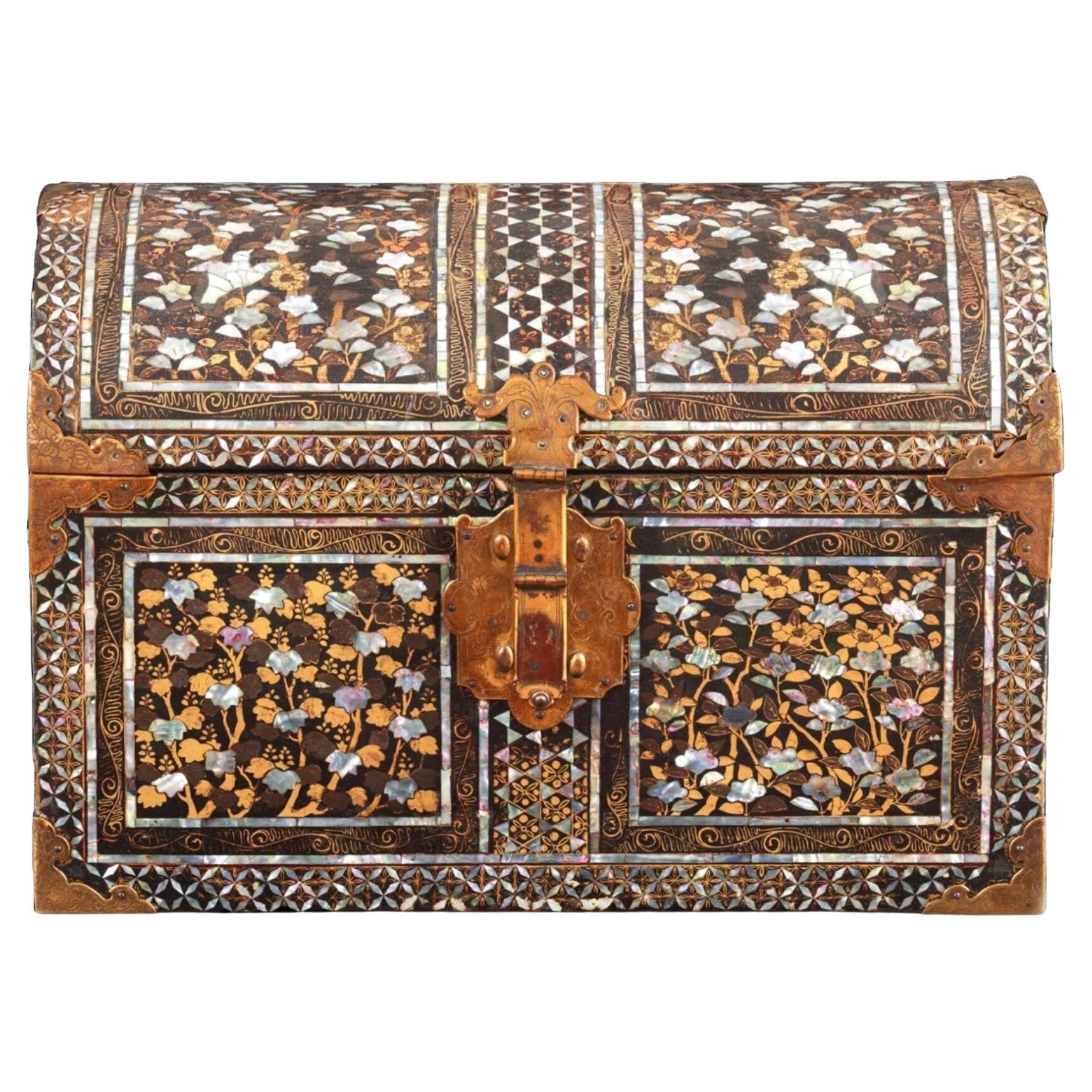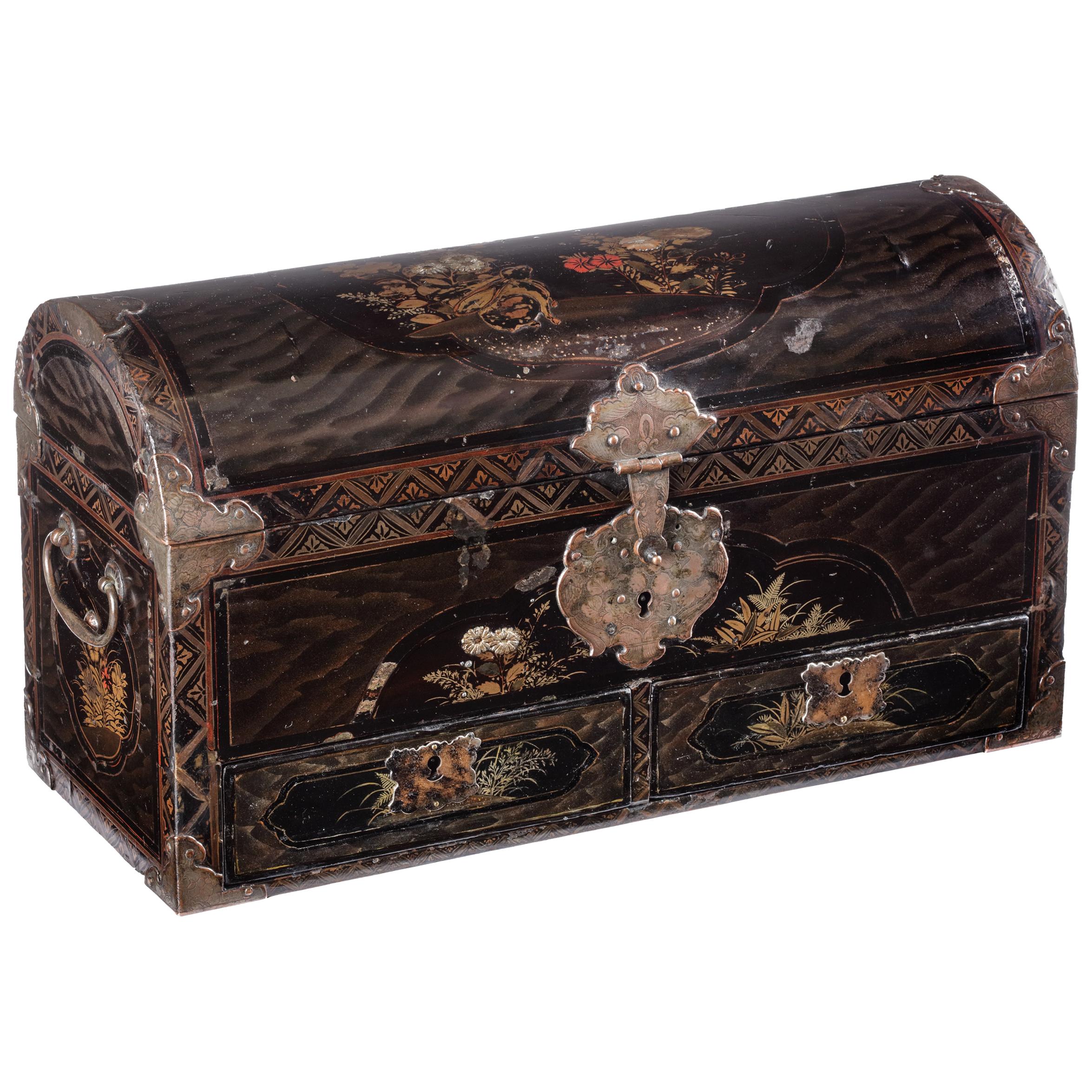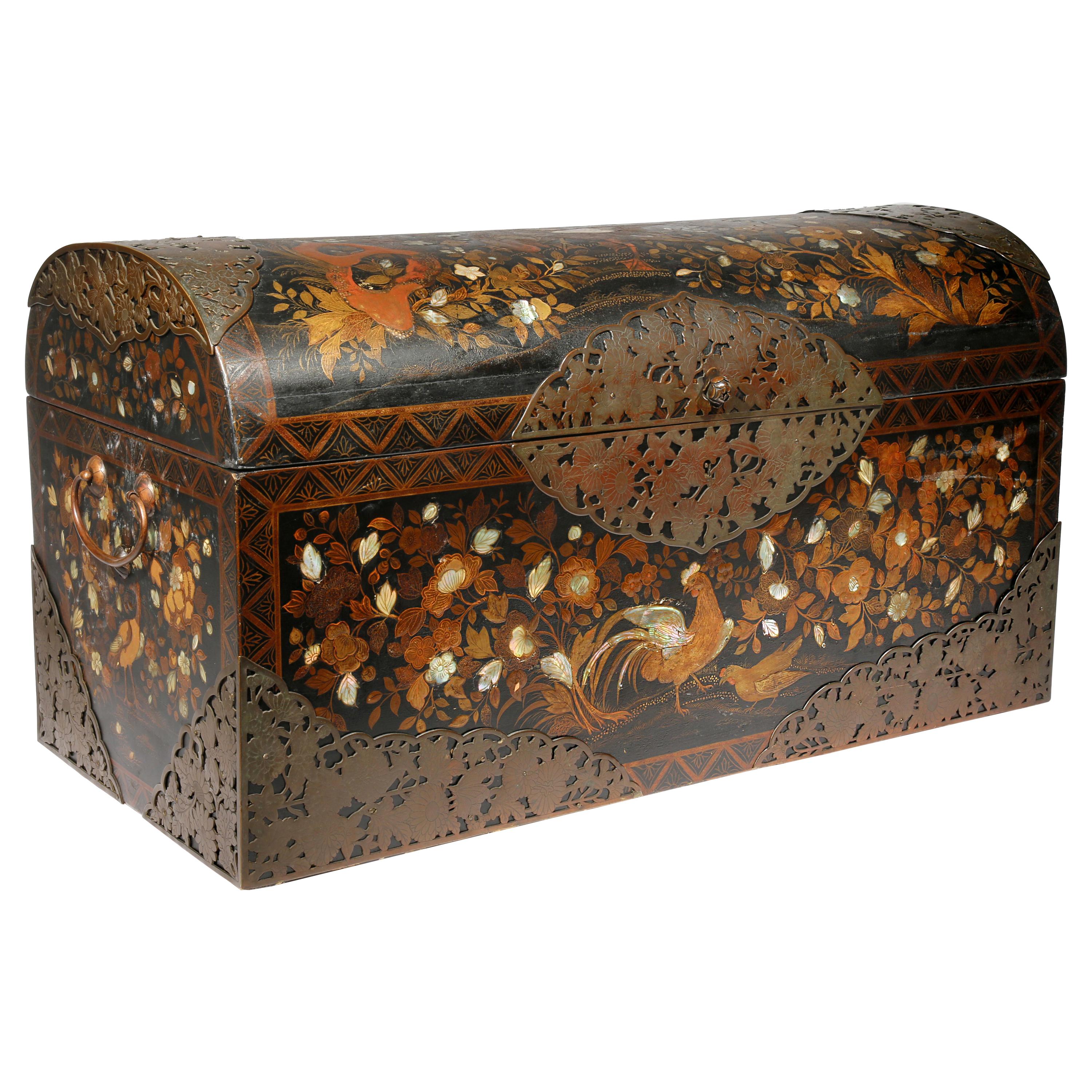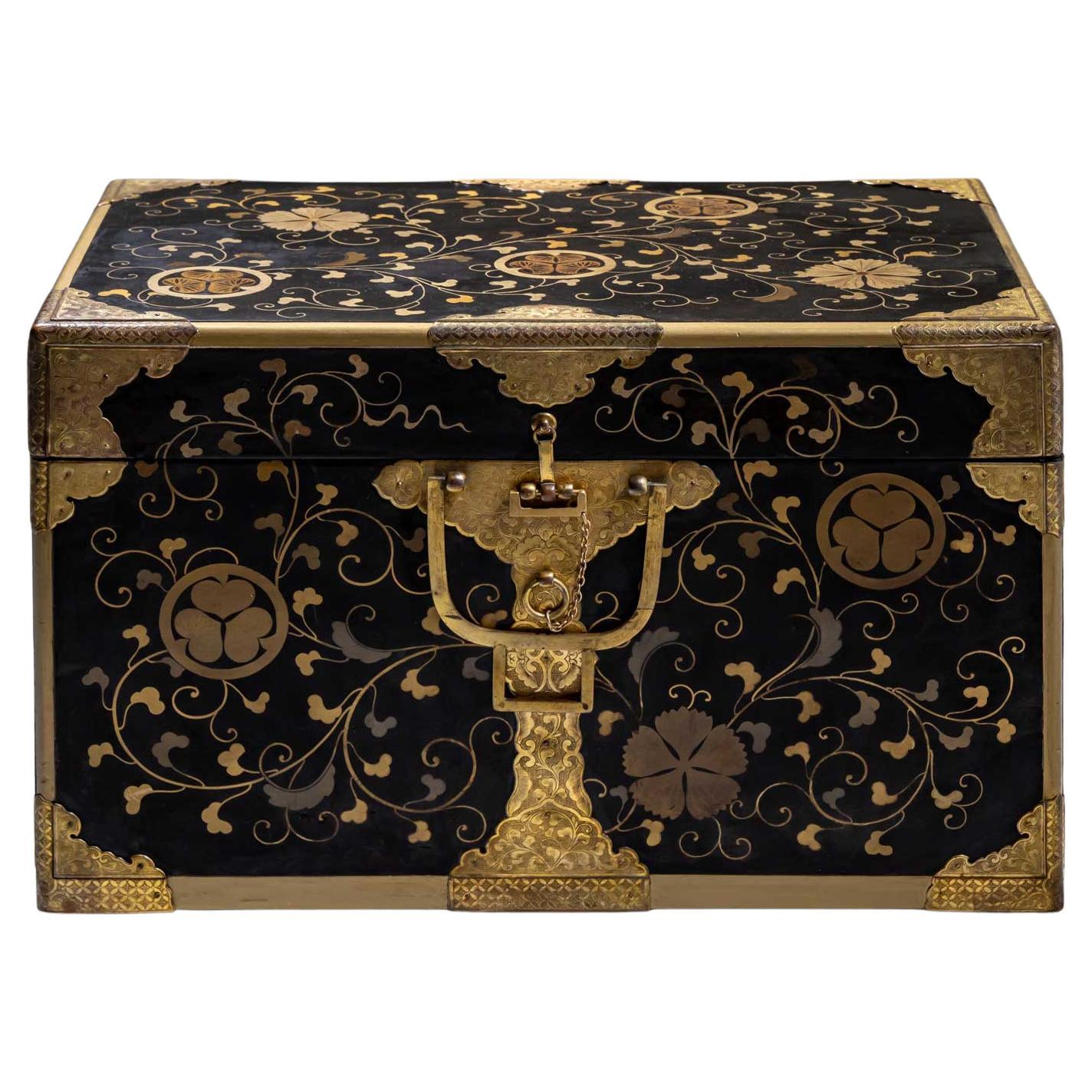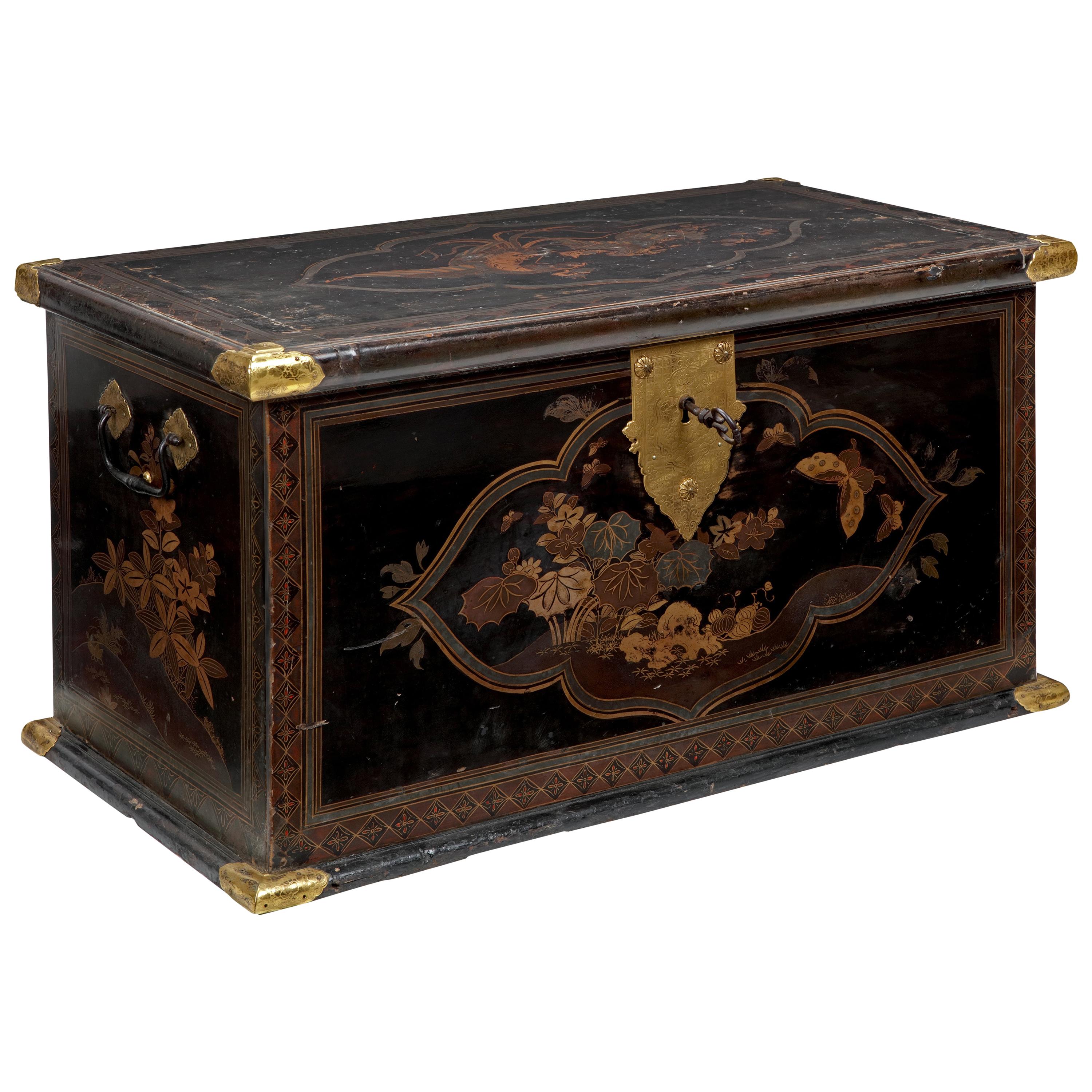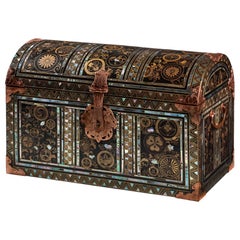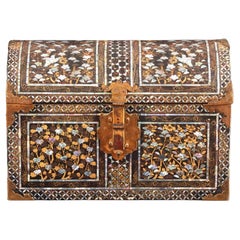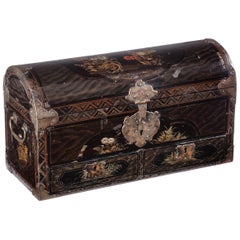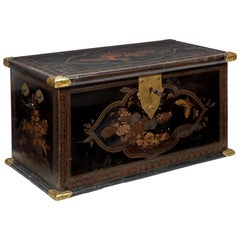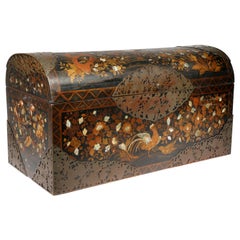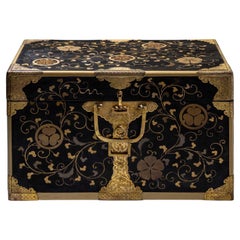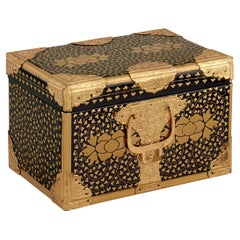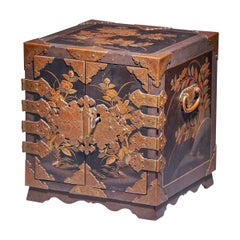Items Similar to Large Japanese Namban Lacquer Coffer Arqueta, 16th Century
Want more images or videos?
Request additional images or videos from the seller
1 of 5
Large Japanese Namban Lacquer Coffer Arqueta, 16th Century
$65,844.61
£48,570.54
€55,000
CA$91,230.99
A$98,999.54
CHF 52,461.03
MX$1,214,181.13
NOK 649,201.48
SEK 613,461.03
DKK 418,814.50
About the Item
A large Japanese Namban lacquer arqueta coffer for the Portuguese market
Kyoto, Momoyama-period, late 16th century
In Hinoki cypress lacquered in black (urishi), decorated in gold lacquer (hiramaki-é), inlaid with mother of pearl (raden) and gilt copper mounts, three panels separated by geometric bands on the lid and body, showing flying long-tailed birds, a lion, butterflies and a tortoise amongst dense foliage of trees, bamboos and flowering plants.
Measures: H. 42 x W. 87.3 x D. 30 cm
Note:
Already in the late 16th century, several are documented in European royal collections. Later in the 17th century, after the Portuguese had been expelled from Japan in 1630 and the Dutch VOC traders were the only Europeans allowed in Japan, the style of the Japanese export lacquer boxes and coffers changed, becoming more pictorial in design, executed in gold lacquer (hiramaki-e and takamaki-e) on a plain black lacquered ground without separate panels, little or no inlay of mother of pearl and no longer with the semi-cylindrical lid (see: Japanese Export Lacquer, Oliver Impey & Christiaan Jörg, 2005). This Namban lacquered wood coffer of long rectangular form and semi-cylindrical lid is an example of the early type of Japanese export lacquers made for the Portuguese.
These larger coffers were called Arqueta and unlike the smaller boxes had carrying handles on the sides and all corners protected by gilt metal fittings. The Portuguese were the first Europeans in Japan and brought new furniture shapes which gave rise to a new type of Japanese lacquer-ware inspired by European models. The travelling Portuguese Jesuits and later the Spanish Franciscans missionaries ordered many small liturgical objects, such as altarpiece, crucifix, oratory and needed boxes or arqueta to transport or store these things, their other belongings and their garments. But more importantly, these boxes and coffers were among the first examples of Japanese export art to reach the (royal) European markets.
- Dimensions:Height: 16.54 in (42 cm)Width: 34.45 in (87.5 cm)Depth: 11.82 in (30 cm)
- Materials and Techniques:
- Place of Origin:
- Period:
- Date of Manufacture:1570-1600
- Condition:Wear consistent with age and use. Some fading to the lacquer on top, but in overall very good condition.
- Seller Location:Amsterdam, NL
- Reference Number:1stDibs: LU5458220859842
About the Seller
5.0
Recognized Seller
These prestigious sellers are industry leaders and represent the highest echelon for item quality and design.
Established in 1985
1stDibs seller since 2020
23 sales on 1stDibs
Typical response time: 5 hours
- ShippingRetrieving quote...Shipping from: Amsterdam, Netherlands
- Return Policy
Authenticity Guarantee
In the unlikely event there’s an issue with an item’s authenticity, contact us within 1 year for a full refund. DetailsMoney-Back Guarantee
If your item is not as described, is damaged in transit, or does not arrive, contact us within 7 days for a full refund. Details24-Hour Cancellation
You have a 24-hour grace period in which to reconsider your purchase, with no questions asked.Vetted Professional Sellers
Our world-class sellers must adhere to strict standards for service and quality, maintaining the integrity of our listings.Price-Match Guarantee
If you find that a seller listed the same item for a lower price elsewhere, we’ll match it.Trusted Global Delivery
Our best-in-class carrier network provides specialized shipping options worldwide, including custom delivery.More From This Seller
View AllA rare Japanese Namban export lacquer coffer with Mon emblems
Located in Amsterdam, NL
Late Momoyama period, late 16th century
The coffer is decorated in black lacquer, urushi, on cedar wood, decorated with gold dust and silver, maki-e, and nashiji, mother-of-pearl, r...
Category
Antique 16th Century Japanese Lacquer
Materials
Silver, Copper
Superb Late 16th Century Signed Colonial Japanese Namban Export Lacquer Coffer
Located in Amsterdam, NL
Superb late 16th century signed colonial Japanese Namban export lacquer coffer
Momoyama period, late 16th/early 17th century, inscribed 'Arisato' on the bottom
H. 30.5 x W. 43...
Category
Antique 16th Century Japanese Lacquer
Materials
Cedar, Lacquer
Fine Japanese Namban Lacquer Jewelry Casket, 17th Century
Located in Amsterdam, NL
Japanese Namban lacquer transition-style coffer with two drawers
Kyoto/Nagasaki, circa 1650
The cartouches with gilt and red decorations of leaves...
Category
Antique 17th Century Japanese Edo Lacquer
Materials
Cypress
Large Royal Early 17th Century Japanese Lacquer Chest with Gilt-Bronze Mounts
Located in Amsterdam, NL
A large Japanese transitional lacquer chest with gilt-metal mounts
Edo period, early 17th century
The rectangular chest with flat hinged lid decorated in gold, silver, and red ...
Category
Antique Early 17th Century Japanese Blanket Chests
Materials
Bronze
17th-Century Japanese Namban Lacquer Coffer on French Stand, Possibly by Boulle
By André-Charles Boulle
Located in Amsterdam, NL
An impressive and large Japanese 'Namban' transition-style lacquer coffer with fine gilt copper mounts on a French Re´gence base, possibly by André-Charles Boulle (1642-1732)
Kyoto, 1640-1650, the base 18th century
?The coffer with shaped cartouches on a nashiji ground on the lid, front and sides, with fine decorations in various techniques: takimaki-e (high relief), tsuke-gaki (drawing with narrow lacquer lines and over sprinkling with gold and silver), usuniku-takamei-e (demi relief), kimekomi (pushed inside) and accents of kirigane (small geometrical metal mosaics). Inside the cartouche on the lid a landscape with volcanos...
Category
Antique 17th Century Japanese Lacquer
Materials
Brass, Ormolu
Portuguese-colonial Japanese Namban lacquer Vargueno Cabinet, circa 1600
Located in Amsterdam, NL
A Portuguese-colonial Japanese Namban lacquer vargueno cabinet
Momoyama period, circa 1600
H. 43 x W. 64.5 x D. 36 cm
Wood, black lacquered and deco...
Category
Antique Early 1600s Japanese Antiquities
Materials
Gold, Brass
You May Also Like
Japanese Namban Lacquer and Inlay Coffer Momoyama Period
Located in Atlanta, GA
A rare Japanese Namban Lacquer domed coffer circa 1570-1610s of Azuchi-Momoyama to early Edo period. These types of lacquerware were made for export to ...
Category
Antique 16th Century Japanese Japonisme Lacquer
Materials
Wood, Lacquer
Japanese Lacquer Chest, Edo Period
Located in Greding, DE
Small rectangular Japanese chest with gold lacquer decoration in the form of leaf tendrils. The chest is decorated with cut-out and ornamentally engraved fittings on the corners and ...
Category
Antique 18th Century Japanese Edo Decorative Boxes
Materials
Brass
Edo-Period Lacquerware Chest
Located in New Orleans, LA
Edo-Period Lacquerware Chest
19th-century
This exquisite chest, inspired by Hasami-Bako travel trunks, is a striking example of Japanese lacquerware. The hiramaki-e technique—applie...
Category
Antique 19th Century Japanese Edo Decorative Boxes
Materials
Gold
Important Early Edo Period 17th Century Miniature Japanese Lacquer Cabinet
Located in Oxfordshire, United Kingdom
A Rare and Important 17th Century Miniature Japanese Lacquer Cabinet, 19 cm H, 17cm W, 16.5cm D.
The exquisitely decorated cabinet depicts fine floral raised scenes to each side. l...
Category
Antique 17th Century Decorative Boxes
Materials
Lacquer
Japanese Lacquered and Gold Leaf Storage Trunk (Nagamochi)
Located in CA, CA
A fine lacquered and gold leaf Nagamochi dating from the late 18th century or early 19th century.
The exterior of the trunk and its gilded metal fittings are decorated with a folia...
Category
Antique Late 18th Century Japanese Edo Decorative Boxes
Materials
Gold Leaf
Early 19th Century Chinese Export Lacquer Sewing Box With Carved Bone Contents
Located in Charlottesville, VA
A richly decorated early 19th century Chinese export sewing or work box in black lacquer, detailed throughout with intricate gilt landscapes and figures. The interior retains a full ...
Category
Antique Early 19th Century Chinese Decorative Boxes
Materials
Brass
More Ways To Browse
Japanese Wood Objects
Wood 16th Century
16th Century Wood Furniture
Antique Mother Of Pearl Box
Mother Of Pearl Inlayed Boxes
Black Lacquer Mother Of Pearl Inlay Furniture
Dutch Voc
17th Century Portuguese
Japanese Pearl Of Mother Box
E Pearl
Large Lacquer Box
Lacquered Large Boxes
Pearl Inlay Box
Coffer Box
Mother Of Pearl Inlaid Lacquer Box
16th Century Japanese
Black Lacquer Pearl Inlay Box
Black Lacquer And Mother Of Pearl Panels
